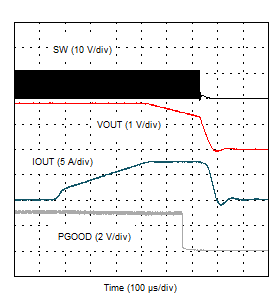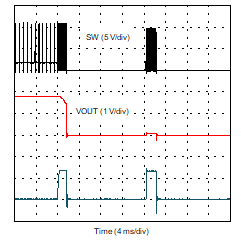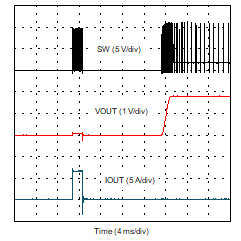SNVU658B March 2020 – May 2021 TPS54J060 , TPS54J061
- Trademarks
- 1Introduction
-
2Test Setup and Results
- 2.1 Input/Output Connections
- 2.2 Start Up Procedure
- 2.3 Efficiency
- 2.4 Load and Line Regulation
- 2.5 Load Transients
- 2.6 Loop Characteristics
- 2.7 Output Voltage Ripple
- 2.8 Input Voltage Ripple
- 2.9 Powering Up and Down with EN
- 2.10 Powering Up and Down With VIN
- 2.11 Start-Up Into Pre-Bias
- 2.12 Current Limit
- 3Schematic, List of Materials, and Layout
- Revision History
2.12 Current Limit
Figure 2-27 shows the latch off current limit of the TPS54J060EVM-067. The output current ramps up to a constant current of 7.5 A set by the electronic load and the output voltage begins to drop due to the valley current limit of the TPS54J060. When the output voltage drops below the under voltage protection threshold, the TPS54J060 latches off. As a result of the latch off protection, the output will only recover after pulling EN pin low then high or turning the input voltage off then on.
Figure 2-28 and Figure 2-29 shows the hiccup current limit of the TPS54J061EVM-067. When the output voltage drops below the UVP threshold, the TPS54J061 stops switching and after the hiccup timeout period attempts to restart. When the overload is removed the output of the TPS54J061 recovers.
 Figure 2-27 TPS54J060EVM-067 Latch Off Current
Limit
Figure 2-27 TPS54J060EVM-067 Latch Off Current
Limit Figure 2-28 TPS54J061EVM-067 Entering Hiccup
Figure 2-28 TPS54J061EVM-067 Entering Hiccup Figure 2-29 TPS54J061EVM-067 Recovering From Hiccup
Figure 2-29 TPS54J061EVM-067 Recovering From Hiccup